A World Turned Upside Down – 50 Years and More of the Planet of the Apes
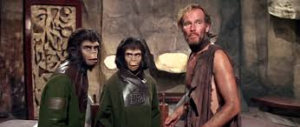
The imminent release of Matt Reeves’s War for the Planet of the Apes is the occasion for us to look back at that particular film franchise generally and its influence and continued relevance within the science fiction genre as a whole. For the record, War for the Planet of the Apes will be the ninth film in a series which – to date – has produced five original films (between 1968 and 1973), a so-so remake and two further films in an excellent recent reboot. It’s not bad for a short novel first published in 1963 by an author who considered it to be one of his lesser works. French writer Pierre Boulle’s original source material, La Planete des Singes, tells the story of one Ulysse Merou, a ‘little-known journalist’ who, along with his two companions, lands on a planet bearing a strong resemblance to Earth. Naming it Soror on their arrival, the group soon realise that much is amiss on this future world where apes are the dominant and civilised species compared to humans who are little more than animal-like, inferior in intelligence, and completely mute. Captured and caged by this ruling class, Merou attempts to communicate with his oppressors and make sense of this upside-down social system. As per the subsequent 1968 film, his principal allies on the planet are the benign chimpanzees Zira and Cornelius. Another feature of the novel which the original film transposes is the innate hierarchy which exists among the monkeys themselves: apes are the labourers and warriors; chimpanzees tend to be the intellectuals and scientists; orangutans meantime represent the aristocrats and political leaders. Travelling to a lost prehistoric city with Cornelius, Merou soon begins to uncover the true reason why humans are so low down in this pecking order – a ‘cerebral laziness’ took hold many centuries before on Soror and the monkeys, who were kept for menial tasks, thrived as the human race stagnated. In a climactic scene, Merou returns to present-day France with his son and the beautiful Nova only to find that apes now rule his world as well. There is no explanation presented as to how the simians have come to wear the uniforms of police officers and other officials at Orly Airport in France. The monkeys are in the ascendancy and little in the way of hope is proffered for mankind. This downbeat note is also reflected in Boulle’s book-ending device which frames the overall narrative. Merou’s story (his message in a bottle) is read by two chimpanzees who are vacationing in space. They promptly dismiss the tale as being fabricated and totally impossible. Humans are not capable of such thought and endeavour they believe; apes are the enlightened race and will remain so for all time.
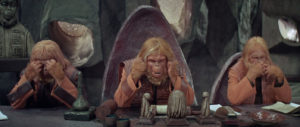
Boulle did not envisage any great screen potential for his novel, but, nevertheless, sold the film rights when American producer Arthur P. Jacobs expressed a keen interest. The Doctor Dolittle producer became a key figure in the franchise’s inception and further development. He spent a number of years seeking the backing of a major studio before convincing the powers-that-be at 20th Century Fox that the science fiction novel (which its writer insisted was more properly social fantasy) could translate effectively onto the big screen. The agreement of Ben-Hur leading man Charlton Heston to star in the film was a major step forward in this respect and led to a famous 1966 screen test involving him and his Ten Commandments co-star Edward G. Robinson. The Twilight Zone’s Rod Serling wrote the original screenplay adaptation (which conceived of the film’s famous ending), but it was writer Michael Wilson who made an even more telling contribution with regard to his idea of rendering the ape society far less advanced than in Boulle’s novel; significantly, this had the effect of lowering estimated production costs making the project far more attractive and achievable in budgetary terms. Planet of the Apes began principal photography in 1967 and was released to critical acclaim in early 1968. Justifiably regarded as a classic of its kind, the original film is probably best remembered for its iconic finale involving a certain neoclassical sculpture from New York City. The make-up artist John Chambers won an honourary Academy Award for his outstanding make-up achievement. The famous line ‘Get your stinking paws off me, you damned dirty ape’ is ranked at number 66 on the American Film Institute’s 100 Years…100 Movie Quotes list. The Oscar-nominated score by Jerry Goldsmith is still highly regarded today and sits at number 18 on the AFI’s 100 Years of Film Scores.
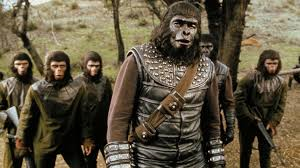
A box office smash is never overlooked in Hollywood and Planet’s considerable success in this regard prompted a swiftly-prepared sequel which was theatrically released in 1970. Beneath the Planet of the Apes is one of the weaker entries in the series as a whole, but its robust performance in box office terms convinced Jacobs and 20th Century Fox that the Planet films had franchise potential. The much stronger Escape from the Planet of the Apes (1971) centered on the chimpanzee characters Cornelius and Zira (Roddy McDowall and Kim Hunter) as they travel back to contemporary Earth. McDowall (one of the undoubted stalwarts of the entire series) played the couple’s son in two further films released in 1972 and 1973 – Conquest of the Planet of the Apes and Battle for the Planet of the Apes. Less than two weeks after the fifth film’s release Arthur P. Jacobs sadly passed away at the much-too-early age of 51. The declining figures at the box office and Jacobs’s untimely death did not deter the studio, and Fox pressed ahead with its plans for a television series which subsequently aired on CBS in the latter half of 1974. Consisting of just 14 episodes in total, the show was short-lived (owing to low ratings), but is certainly not without its merits as shows of this order go. A very familiar face among the cast was Roddy McDowall who played a chimpanzee named Galen. Ron Harper and James Naughton played the roles of the astronauts Virdon and Burke who crash-land on a future version of Earth. Mark Lenard – better known to many as Mr. Spock’s father Sarek from Star Trek – played the chief ape antagonist Urko. The 13-episode animated television series Return to the Planet of the Apes (1975) operated on a similar premise as its live action counterpart – a number of astronauts find themselves on a planet where apes enjoy dominion and man is consigned to a most humble, even degraded role. In each episode the main human characters are required to stay one step ahead of the pursuing simians just as they make sense of this alien world. The animated series was notable also for the fact that it resembled Boulle’s novel more closely with respect to its portrayal of a technologically-advanced ape culture replete with modern-day conveniences and modes of transport. A prominent member of the voice cast was Austin Stoker who would go on to star in John Carpenter’s highly influential 1976 film Assault on Precinct 13.
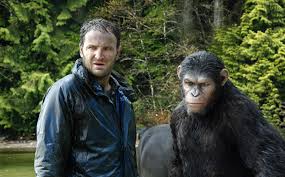
The much-dreaded Hollywood term ‘development hell’ can be applied to the series from the late-1980s through to the 1990s as several producers and writers aspired to revive the franchise with new concepts and fresh approaches. If you read up on the history of this particular period, you’ll see some very well-known names such as Oliver Stone, James Cameron and Arnold Schwarzenegger being mentioned in this respect. Finally, in the summer movie season of 2001, a new Planet film appeared by way of Tim Burton’s re-imagining of the Boulle novel and 1968 original. Planet of the Apes (2001) fared quite well at the international box office, but was not warmly received by critics. Burton himself found the tightly-scheduled shoot extremely onerous and did not evince any great desire to return for a sequel. In any event, Fox decided not to proceed with one and the next film in the franchise did not appear for another 10 years. The two reboot films to date – 2011’s Rise of the Planet of the Apes and 2014’s Dawn of the Planet of the Apes – have, as we know, received especial praise for their visual effects and the performance-capture acting by the cast members, Andy Serkis in particular. But, thankfully, here also is a reboot series that works owing to its strong storytelling and heartfelt character portrayals. Other film franchises could well take a leaf out of its book. The success and critical praise enjoyed by both Rise and Dawn have deservedly led to a third reboot film. War for the Planet of the Apes has a tough act to follow, but the return of Matt Reeves to the director’s chair and Serkis as Caesar augur well for the ninth film. Actors appearing for the first time in the series include the ubiquitous Woody Harrelson and Steve Zahn. A fourth reboot film (and tenth overall in the series) is said to be in the works at the time of this article. Speaking on the topic of further sequels, Andy Serkis has said that, ‘The journey will continue.’ On that basis it seems as if the apes are here to stay with us for the foreseeable future. One would wonder what author Pierre Boulle (who passed away in 1994) would make of it all. A novel which he did not have huge personal regard for has spawned a film franchise which – imbued with a new lease of life – looks set to run and run.
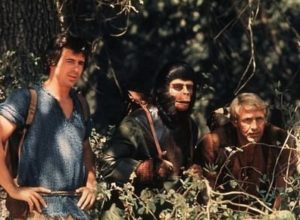
In 1998 Roddy McDowall presented a documentary on the series which focused for the most part on the original five films. Appropriately titled Behind the Planet of the Apes, the documentary concluded with McDowall’s reflections on some of the themes examined by the series to that point, as well as throwing up some exciting possibilities for the future – ‘Planet of the Apes holds up a mirror and asks us simply to look at ourselves and our fears and prejudices, and our hopes and dreams, but, as a new millennium dawns, can we expect more exciting adventures on the Planet of the Apes? Perhaps the answer lies somewhere in the stars. Or maybe right here on Earth.’ McDowall’s words have proven somewhat prescient as the reboot series has demonstrated and one can only imagine what may lie ahead for the franchise should War for the Planet of the Apes go on to be a substantial hit at the box office. The original Boulle novel is almost 55 years old and next year – 2018 – the first film in the series will celebrate its 50th anniversary. The ape saga on screen has endured for almost half a century now and deserves its prestigious place in the science fiction genre as a whole. To mark the occasion of the release of War for the Planet of the Apes, I’ve taken a look at the eight films which have preceded it between 1968 and 2014. If you haven’t seen some of these already, then you might consider familiarising yourself with them as War arrives in cinema theatres around the world. The ones which I consider to be the best among them will be evident from my remarks below. Enjoy and – in 2017 and beyond – go ape for this highly durable film franchise.
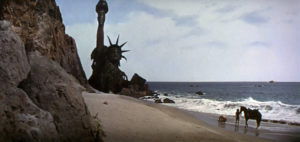
Planet of the Apes (Franklin J. Schaffner 1968)
‘I can’t help thinking that somewhere in the universe there has to be something better than man,’ Charlton Heston’s Taylor opines at the beginning of the seminal 1968 science fiction film that introduced the ape saga to cinema fans across the world. Taylor is one of a group of four astronauts who crash-land on a mysterious and – to them – unknown planet where hairy primates are very much in the ascendancy and humans mute and seemingly unintelligent creatures. Based loosely on Pierre Boulle’s 1963 novel La Planete des Singes, the first film in the series took quite an amount of time (and persuasion) to bring to the big screen. The efforts of producer Arthur P. Jacobs should receive due credit here, as also the case with screen writers Rod Serling and Michael Wilson in adapting Boulle’s work. Serling was the one who conceived that famous ending which was shot on Zuma Beach in California, but it was Wilson who came up with the idea of portraying a more primitive ape society to align more closely with the production’s budgetary constraints. A screen test which was shot in 1966 – involving Heston and Edward G. Robinson – convinced 20th Century Fox vice-president Richard D. Zanuck that the premise and make-up could work; the subsequent efforts of prosthetic expert John Chambers broke new ground in this field (and earned the latter an honourary Oscar for his efforts). A wonderful cast includes Heston as Taylor, Roddy McDowall as Cornelius, Kim Hunter as Zira, Maurice Evans as Dr. Zaius (Edward G. Robinson withdrew from the role just prior to principal photography) and James Whitmore as the President of the Assembly. The famous line uttered by Taylor as he regains his speech (‘Get your stinking paws off me, you damned dirty ape’) was aided by the fact that Heston was exhausted from the significant physical demands of filming and recovering from a bout of flu. The lead actor also played a significant role off-screen in bringing director Schaffner on board with whom he had previously collaborated on 1965’s The War Lord. The avant-garde score by Jerry Goldsmith also deserves much praise and mention with respect to its innovative use of instruments such as the ram horn. A deserved critical and commercial success in its day, it’s hard to believe that this first film in the franchise is some 50 years old so fresh and potent is its underlying message and aforementioned make-up effects. The ending, of course, is one of the most iconic in all of cinema (‘We finally really did it! God damn you all to hell!’), but also watch out for clever lines such as the funeral oration overheard during Taylor’s attempted escape (‘The dear departed once said to me, I never met an ape I didn’t like’) and the visual allusion to the see no evil, speak no evil, hear no evil monkeys during the courtroom scene. A science fiction classic that has earned its place on a list of the very best in this particular genre.
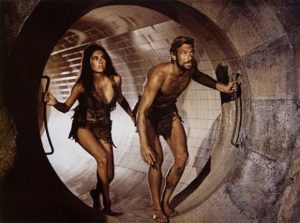
Beneath the Planet of the Apes (Ted Post 1970)
Charlton Heston returned for this 1970 sequel, but only on the proviso that his role be strictly limited in terms of screen time and that his character be killed off; the general production of Beneath also suffers from a similar curtailment which was employed with respect to its budget ($3.4 million as opposed to the original’s $5.8 million). Producer Jacobs approached both Boulle and Serling for story concepts for the follow-up film, but, dissatisfied with their ideas, hired British screenwriter Paul Dehn – who would subsequently go on to make a significant contribution to the franchise as a whole. The second film begins with Planet’s closing scenes as Taylor (Heston) and Nova (Linda Harrison) ride off on horseback and discover the grim remains of the Statue of Liberty. Soon after this, Taylor disappears in highly unusual circumstances and a new character Brent (James Franciscus) – who is searching for Taylor and his lost crew – is introduced on the planet’s surface. ‘My God did we finally do it? Did we finally really do it?’ the latter asks himself in a very obvious reference to the first film’s climactic moment and, if truth be told, Beneath the Planet of the Apes is one of the weaker entries in the franchise generally more than smacking of a very rushed sequel. Directed by Ted Post (of Rawhide, Gunsmoke and Peyton Place fame), Beneath has a very lame premise concerning a colony of subterranean human mutants who worship an ancient nuclear bomb (‘Glory be to the bomb and to the holy fallout,’ they give out in such adoration); other absurd scenes include their mind-controlling techniques as used on both Brent and Taylor (Heston finally re-appearing towards the film’s silly denouement), and an utterly bizarre sequence in which they take off their masks (revealing holocaust burns and deformities) and sing All Things Bright and Beautiful. This was the only Planet film of the original five which did not feature Roddy McDowall (owing to scheduling conflicts) – he was replaced in the role of Cornelius by fellow thespian David Watson. Kim Hunter and Maurice Evans returned respectively as Zira and Dr. Zaius. Given that he suggested the manner of his character’s death at the end of the film, there can be little doubt that Charlton Heston had no interest in any further involvement in the series generally. But there was indeed life yet in the ape-ventures generally. Despite poor critical reviews, Beneath performed very well at the box office and spawned another sequel the following year.
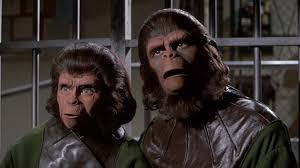
Escape from the Planet of the Apes (Don Taylor 1971)
A brief telegram from Arthur P. Jacobs to writer Paul Dehn left little doubt as to the franchise’s future following the considerable success of Beneath – ‘Apes exist, sequel required.’ But the immediate problem facing Dehn was how to construct such a further chapter in the ape series following the ostensibly conclusive events of that second film. Wasn’t the planet destroyed? Didn’t apes and humans finally perish in the wake of the nuclear explosion? Dehn came up with a very clever idea. Recalling Taylor’s ship from the first film, he concocted a story line in which Cornelius and Zira (McDowall and Hunter re-teaming once again) travel back through time to present-day Earth with a third chimpanzee Dr. Milo (Sal Mineo). The apes are taken to Los Angeles Zoo, where Milo is subsequently killed by a gorilla, leaving Cornelius and Zira in the hands of Dr. Lewis Dixon (Bradford Dillman) and Dr. Stephanie Branton (Natalie Trundy) whom they befriend. The couple become quite the celebrities as they shop for clothes in downtown L.A. and enjoy the modern-day conveniences of a plush hotel, but question marks still remain with respect to the fate of Taylor, how apes generally came to dominate man in the future and – even more critically – the nature of experiments carried out by Zira on humans in her role as a veterinarian. Chief among those who suspect her of possible crimes against humanity is Dr. Otto Hasslein (Eric Braeden) who seeks to bend the US President’s ear in this regard. Matters are further complicated when it transpires that Zira is pregnant with Cornelius’s child. Happily, Escape is a far better film than its predecessor and much of the credit for this goes to Dehn’s witty (if, ultimately, downbeat-ending screenplay), the uncomplicated direction of actor-director Don Taylor and the as-always wonderful performances of Kim Hunter and Roddy McDowall. Asked by a member of the presidential commission if the other one (meaning Cornelius) talks, the quick-thinking male chimpanzee replies, ‘Only when she lets me.’ Mexican actor Ricardo Montalban features as the kindly Senor Armando, the owner of a circus who provides the wanted chimpanzees with much-needed shelter as they seek to evade the authorities. Montalban would appear in the fourth film as well, which was made possible, in part, by the more than moderate success of this particular entry. Escape from the Planet of the Apes was also the best-reviewed film of the four 1970s sequels with particular praise reserved for the central performances of McDowall and Hunter (who made her final appearance in the series as a whole).
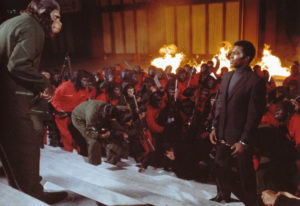
Conquest of the Planet of the Apes (J. Lee Thompson 1972)
The fourth film in the original series is quite a departure generally with respect to its much grittier tone and the level of violence which permeates it. J. Lee Thompson (The Guns of Navarone, Cape Fear), who had more than a passing interest in the franchise having been considered by Arthur P. Jacobs for the first film, was hired by the producer and employed a meticulous approach to his work on the production. One of the more striking aspects of Conquest’s visual design is the use of colour particularly with regard to the apes and the humans (vibrant costumes worn by the former group and more muted in relation to the latter). Scriptwriter Paul Dehn – a veteran on the series by this time – made several allusions to racial conflicts which were endemic in contemporary America of the time and the whole theme of such discrimination – which was touched upon in Escape from the Planet of the Apes – is expanded here. Conquest is set in an unnamed U.S. city in the year 1991. A mysterious disease has wiped out the dog and cat populations on earth and apes have tentatively come to replace them as household pets. Owing to their underlying intelligence, the simians have been trained to perform menial household tasks and a culture of slave labour has, in fact, become the norm. The cityscape in which Conquest is set is indeed a bleak one (it was mostly shot in L.A’s Century City) and there’s more than a feel of the police state about it as apes are disciplined and punished whenever they fail to perform their duties. Caesar (Roddy McDowall), the grown-up son of Cornelius and Zira, is shocked at the nature of such a world, particularly following the death of his human friend Armando (Ricardo Montalban – reprising his role from Escape) and his own subjugation as a forced labourer. The empowered chimpanzee subsequently leads a rebellion against his oppressors which culminates in his declaration of the, ‘birth of the planet of the apes.’ Considered by audiences and critics of the day as the most violent entry thus far, Conquest had its ultra-pessimistic ending raised a few notches in post-production by way of a more conciliatory tone inserted into Caesar’s final speech. Nonetheless, it still remains quite a stark depiction of the future and probably the darkest of all the Planet films. 2011’s reboot Rise of the Planet of the Apes has been compared to it with regard to its somewhat similar premise.
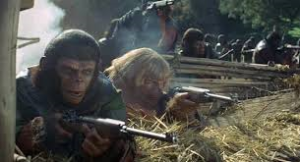
Battle for the Planet of the Apes (J. Lee Thompson 1973)
Paul Dehn’s original outline for this fifth film was not accepted by the studio or Jacobs and so the producers brought in the screenwriting couple of John William Corrington and Joyce Hooper Corrington who had delivered the script for 1971’s The Omega Man (which, incidentally, starred Charlton Heston). Dehn eventually received a story credit for his input, but Battle remains the most poorly received of the series generally in spite of the best efforts of the writers, Roddy McDowall and J. Lee Thompson. The returning director was particularly frustrated with the severely limited budget he had at his disposal and, in terms of scope and production values, Battle is quite bereft of the epic scale and range its title suggests. An off-screen nuclear war has occurred since the events of Conquest and Caesar and his fellow apes now co-exist uneasily with a group of humans. The central character himself has been rendered much softer here; he is no longer militant, but this is not to everyone’s liking, especially a rebel in the ape fold named Aldo. Battle is quite reminiscent of Beneath the Planet of the Apes insofar that there is again a city of radioactive-stricken humans who absolutely balk at the notion of simians who can prosper and rule. Caesar finds himself under threat from this group and the faction which supports Aldo and the titular battle soon ensues. Along the way, the ape leader suffers personal loss as well – his young son Cornelius is killed by the merciless Aldo. Arthur P. Jacobs sadly passed away less than two weeks after the theatrical release of Battle (he was 51) and there was more than a pervading sense that the series had come to its logical conclusion even before principal photography began. The subsequent film was indeed billed as The Final Chapter, but did quite well at the box office and plans for a television series came to fruition the following year. Watch out for a cameo by John Huston by the way. Playing a much-revered ape, known simply as The Lawgiver, the director-actor bookends the film with a narrative exposition told hundreds of years after Caesar has died and his name passed into legend. The final shot of a tear trickling from the eye of a statue of the venerated ape leader is left open to the viewer’s interpretation. Is this despondency at having failed somehow in his own personal mission or joy at the achievements realised by his descendants? You decide.
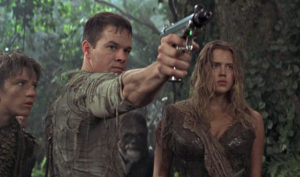
Planet of the Apes (Tim Burton 2001)
After a cinematic break of some 28 years the apes returned in Tim Burton’s 2001 re-imagining of the 1968 original film version and Pierre Boulle’s source material. Mark Wahlberg plays Captain Leo Davidson, a United States Air Force astronaut, who passes through a portal to another planet where apes govern and humans are reduced to a state of mere servitude. Davidson is captured by these hairy rulers of the planet (‘Get your stinking hands off me, you damned dirty human’) and is forced to work as a slave in the house of Senator Sandar (David Warner). There he meets Ari (Helena Bonham Carter), a female chimpanzee who has an absolute abhorrence for the way humans are treated by their simian oppressors. Along with Daena (Estella Warren) and her father Karubi (Kris Kristofferson), Davidson escapes from his position of bondage and seeks to discover how exactly apes have come to dominate man. A moderately successful box office hit the year it was released, the 2001 version of Planet did not occasion any sequels and it would be a further 10 years before another film appeared in the franchise. A common complaint centered on the nature of the confusing ending in which Davidson returns to present-day earth only to find himself surrounded once again by a horde of apes who are dressed as firefighters, police officers and news reporters. English actor Tim Roth – who played the villain of the piece General Thade – subsequently admitted that he could not understand it in spite of seeing the film twice. The shoot evidently was not a very pleasant one for director Tim Burton generally who felt pressured by budgetary constraints and a release date which the powers at 20th Century Fox were adamant he should meet. Paul Giamatti fared best among the cast as Limbo, a shifty orangutan who trades in human slaves, but Tim Roth overcooked his role somewhat as Thade. Charlton Heston made a brief cameo playing Zaius, Thade’s father. This was one of the actor’s final screen appearances and the writers could not resist the temptation of referencing the famous ending to the 1968 original. ‘Damn them all to hell,’ Heston yells just as his character expires in front of his military-oriented son. The line concerns his opinion about humans, but, more fittingly perhaps, it could be directed at the writers and producers of this film who did not quite get it right in this particular instance. Far from a disaster, but a disappointment nonetheless.
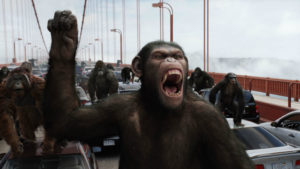
Rise of the Planet of the Apes (Rupert Wyatt 2011)
Now this was much more like it!! The first installment in the rebooted series deservedly garnered praise on its theatrical release and particular acclaim was reserved for the strong storyline, excellent visual effects (which received an Academy Award nomination) and the superb motion capture performance of Andy Serkis (who was already a veteran in this arena having previously worked on Peter Jackson’s Lord of the Rings Trilogy and the director’s 2005 version of King Kong). James Franco plays Will Rodman, a scientist working at a biotech company in San Francisco, who has more than a little personal motivation in the development of a drug to cure Alzheimer’s Disease (his father Charles (John Lithgow) is afflicted with such dementia). Following the failure of an experiment, Will decides to raise a baby chimp named Caesar who displays heightened brainpower beyond his species and more than an acute awareness of his domestic environment. Several years pass and Caesar – now an adolescent – begins to question his origins and exact place in the world. Matters are not helped by an angry clash with a neighbour (whilst protecting a mentally-regressing Charles) and Caesar is confined to a primate facility where he is the subject of persecution at the hands of his fellow apes and the chief custodian. It’s not long before rebellion is in the air as the resourceful Caesar obtains a more powerful version of the intelligence-enhancing drug and duly raises the level of acuity among his fellow apes. A climactic battle scene on San Francisco’s Golden Gate Bridge is one of several good reasons to watch this seventh film in the overall franchise, but let’s also marvel at the aforementioned visual effects and the performances of the cast playing both humans and apes. Serkis, as I mentioned, is the standout here in this regard, but there are also fine turns by Brian Cox, Tom Felton and John Lithgow. Made on a production budget of $93 million, Rise grossed $481 million at the international box office and more than convinced the powers-that-be at 20th Century Fox that – provided with the crucial components of good storytelling, measured direction and a compelling protagonist – there was indeed much vitality still in the Planet series. The studio did not miss a beat and promptly delivered a sequel some three years later.
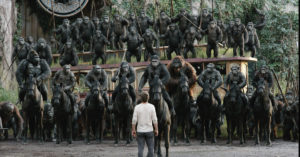
Dawn of the Planet of the Apes (Matt Reeves 2014)
It’s not often that a sequel surpasses its predecessor, but such was the case with Matt Reeves’s excellent 2014 entry in the Planet series which achieved near-universal acclaim and realised a box office haul of $710 million worldwide. Set 10 years after the events of Rise – during which time a pandemic (known as simian flu) has greatly reduced the planet’s human population – Dawn concerns an adult Caesar (Andy Serkis) as he seeks to maintain leadership over his own community of apes, whilst allowing a tentative understanding with a group of humans who are fighting for their own survival. The plot of Dawn is not terribly dissimilar to that of 1973’s Battle for the Planet of the Apes, particularly with regard to the character of a subversive in Caesar’s midst, namely, Koba, the scarred bonobo from Rise who hasn’t forgotten or forgiven humans for their wanton research as he sees it. This force from within proves to be far more dangerous than any from without and the rogue Koba manages to instigate a situation whereby Caesar’s troops attack a human colony in San Francisco and take prisoners, including apes still loyal to Caesar himself (who has been shot by Koba and is now presumed dead). Dawn of the Planet of the Apes is one of the very best in the overall franchise owing to the heightened state of tension it sustains throughout, its robust storyline, assured direction from Cloverfield helmer Reeves, and the emotional resonance which underpins it throughout. And then there’s the terrific cast to boot – Serkis is once again superb as Caesar and he’s ably supported by Jason Clarke, Keri Russell, Gary Oldman and Kodi Smit-McPhee. Toby Kebbell plays the treacherous Koba and Judy Greer plays Caesar’s wife Cornelia. Screenwriters Rick Jaffa and Amanda Silver are back on scripting duties here and their efforts are supplemented by Mark Bomback (who also wrote 2013’s The Wolverine and is on co-writing duties again for 2017’s War for the Planet of the Apes). As per Rise, the visual effects of Dawn are most impressive and deservedly earned an Academy Award nomination for Best Visual Effects. All in all a superior sequel and here’s hoping in advance that War for the Planet of the Apes maintains the very high standard of these excellent reboots.
Keen sense of why the series works (most of the time) and the cultural context but must take issue with the last one of the reboots which I found verging on the unwatchable! The most dislikable cast outside of a Transformers movie – I couldn’t bear to watch the humans at all!! The only reason Clarke ever got a gig was because he resembled Michael Mann – game over, go home mate! It makes you realise how cherishable the original cast were.Despite that my appetite has been whetted for the new one!
I have to say that I really enjoyed Dawn myself, but – as the entire series itself goes – the 1968 original film would still be my personal favourite of the franchise by a country mile. Terrific cast, make-up effects that were ahead of their time, Jerry Goldsmith’s score, an excellent adaptation of the Boulle novel and, of course, an ending which is one of the most famous in cinema history. Much imitated, but will never be equalled.